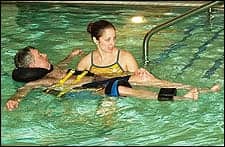 |
| Sara Kittell, MSPT (right), guides a client through an aquatic therapy program. The therapist determines the appropriate activity level for the individual. |
Anyone looking for a good workout can walk into a fitness gym and see a vast number of different machines geared toward working every inch of the body. These fitness facilities typically offer treadmills, step machines, and various weight machines for intrepid spirits ranging from college age to middle age.
But what about the aging Baby Boomers or senior segment of our society? Doctors’ orders send them to the gym as well as to therapy to improve their overall health. For this group of older adults, their treadmills, stationary bikes, and weights may be submerged in 3 to 6 feet of water.
Aquatic therapy is becoming popular for older adults looking for exercise programs that minimize the physiological and psychological effects of aging. Aquatic therapy offers an evolving therapeutic plan for an aging population looking to restore or maintain health and function.
Aquatic therapy pools have a temperature range of 92° to 94°, which is about 6° warmer than the average pool. The pools are often multiple depths, starting shallow and progressing to deeper levels often used for floating therapies.
Aquatic therapy is not new. Working out with part or most of the body underwater has been around for decades. But the idea is quickly evolving into a primary workout option for those 60 years of age and older, because staying in shape at 60 has a different meaning than it does for those who are younger. Common conditions at this age involve arthritis, lower back pain, trauma, and difficulty walking or balancing. These and other maladies can be eased in many cases with a solid aquatic therapy program.
ADVANTAGES OF AQUATIC THERAPY
The advantages of aquatic therapy over so-called “dry land training” are twofold, and each is significant.
First, aquatic therapy enables patients to stay in shape by strengthening muscles without the stress they might experience on dry land. If perfectly relaxed in water, many people will nearly float at the surface. This buoyancy lessens the effect of gravity and reduces impact on the joints. Buoyancy allows the person to achieve increased flexibility and mobility during therapeutic sessions in the water and subsequently during daily activities outside the water.
The second advantage is that water resistance provides a gentle fight as limbs navigate their way through various exercises and patterns of movement, such as walking, in water. The water will match the force provided by the patient when he or she moves through the water. Support can be used as needed, or gradually eliminated to concurrently work on strength, balance, and trunk and abdominal control.
The decreased levels of resistance and weight bearing in the water results in several physiological benefits, including muscle relaxation, a decrease of joint inflammation and soft-tissue inflammation, and increased circulation. The result is improved flexibility and range of motion. In addition, balance issues may be addressed in the water, resulting in more function for activities such as getting dressed or reaching for an object.
GETTING STARTED
Starting an aquatic therapy program begins with the physician. For an acute or chronic problem such as arthritis, aquatic therapy may be the prescribed course of treatment.
Patients do not usually get in the pool on the first day. At the first appointment, a one-on-one, thorough evaluation between the patient and the PT takes place. Problems such as high blood pressure or a previous stroke are often identified, along with impairments, such as range of motion, pain, or strength issues.
If the evaluation shows that the patient is able to exercise in the pool, the aquatic therapy program is then established. It oftentimes involves a 1-month time frame, where the patient may visit the pool two to three times per week for individual 45-minute sessions. The therapist must select the workout level that is most appropriate for the individual. It may be a high level of activity with increased resistance or a low level for those with more serious disabilities.
Aquatic programs vary for each individual, but they may have similar components. For example, the easiest exercises will be completed in a single plane of motion, and as a patient progresses the difficulty increases with movements through multiple planes. An easier movement, for example, may be walking straight ahead. Adding diagonal arm movements to the walking will provide an additional challenge for the patient, as it requires not only strength, but also coordination and balance.
|
To learn more about the benefits of aquatic therapy, read “In the Swim.” |
|
Patients at a higher level of function may use aquatic tools that can further improve strength and range of motion. At most rehab pools, patients will usually see equipment such as ankle weights, paddles to be held in the hands, foam barbells, flotation belts, and noodles. One popular toy includes fins that can be attached to a patient’s wrists or ankles to provide resistance. When wearing these fins, patients gain resistance in multiple directions, maximizing the effort of the patient on the way up and the way down. Other resistance tools, such as weights or foam barbells, are effective only in one direction, as they either assist or resist buoyancy. Underwater treadmills and bicycles are also considered appropriate for aquatic programs for older adults.
Aquatic therapists should join their patients in the pool to help ease the concern of trying a new rehabilitation technique. Being in the water can help therapists ensure that their patients are moving with correct form and using the correct muscles. Many times, older patients can exhibit decreased awareness of how they move and may need multiple cues to ensure they are using the correct form, which is important to reduce stress on the body. By getting into the pool, aquatic therapists can gently put their hands on the patient in an effort to guide them into the correct positions and help the patients realize the benefits of these movements.
FEELING THE PROGRESS
Initially, new patients might be resistant or skeptical toward aquatic therapy. Once patients get in the pool and realize the benefit, they usually take the program very seriously and continue the treatment with an open mind. The water enables patients to move more freely than they do throughout most of their day on dry land. This movement continues once the workout is done because the patients have increased flexibility in their joints for an extended period of time, thanks to increased synovial fluid circulation. As a result, patients do not feel as stiff. They may not have as much trouble getting up from a chair or getting out of bed. Such improvement is the main reason why patients are happy to come back. The progress may not be significant, but it is noticeable.
Aquatic programs have a strong track record of success. But like any other rehabilitation program or athletic program, success is greatly dependent upon the patient’s level of dedication. Once the rehabilitation assignment is over, it is incumbent upon aquatic therapists to fully explain the benefit of continued aquatic therapy, whether it be through monitored individual workouts or an aquatics aerobics class.
With the proper diagnosis, the proper program, and the proper dedication, aquatic therapy can be a highly beneficial regimen for the growing ranks of older adults.
Sara Kittell, MSPT, is a physical therapist, specializing in aquatic therapy, at Good Shepherd Rehabilitation Network, Allentown, Pa. For more information, contact .





